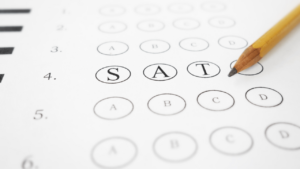The SAT is a standardised global test that a high school student or someone interested in pursuing a bachelor’s degree from another country must take. The SAT Subject Tests were designed to assess a person’s knowledge in various areas or disciplines. On different scales, the scores are measured individually. In this article, we will go over a lot of information in preparation for the SAT Physics subject test.
Table of Contents
The SAT Physics subject test is referred to as SAT II, but it is also known as the Physics SAT. The SAT Physics subject test is designed to assess and identify a candidate’s comprehension and understanding of the fundamental concepts of physics. At the same time, the test assesses the candidate’s ability to apply these ideas to a variety of challenges.
Leap Advantage Virtual Spot Offer Event on May 10th 2024

Last call to secure your spot for Masters in US for Fall ’24 Intake
Leap Advantage Virtual Spot Offer Event on May 10th 2024
Last call to secure your spot for Masters in US for Fall ’24 Intake

Physics SAT Subject Test Pattern
Based on the SAT subject test physics sample paper, the following is the exam pattern for the SAT Physics test:
- The SAT Physics topic test lasts an hour and a half or 60 minutes. There are 75 multiple-choice questions in the test.
- Each question has five possible answers to choose from. It is worth noting that the questions come in a variety of formats.
- Some of the questions are stand-alone, while others are part of a larger group.
- The examinee has a very limited amount of time at their disposal. Each question should take no more than a minute or a few seconds to complete.
- As there is not much time on this test, there are not many challenging questions. A person does not have to go through a time-consuming process of resolving difficult calculative problems.
SAT Physics Syllabus
The SAT Physics syllabus primarily evaluates first-year physics knowledge as well as logical and problem-solving abilities. The following items are included in the syllabus:
- Mechanics
- Magnetism and electricity
- Optics and waves
- Thermodynamics and heat
- Questions on modern physics not related to the topic
Detail Breakdown of SAT Physics Syllabus
Here is the breakdown of the SAT subject test physics syllabus: Mechanics: 36 to 42 per cent
- Kinematics includes concepts such as velocity, acceleration, one-dimensional motion, and projectile motion.
- Force, Newton’s laws, statics, and friction are all examples of dynamics.
- Potential and kinetic energy, work, power, impulse, and conservation laws are all examples of energy and momentum.
- Uniform circular motion and centripetal force are examples of circular motion.
- Simple harmonic motions, such as the pendulum and mass on a spring, are examples of simple harmonic motion.
- The law of gravitation, orbits and Kepler’s laws are all examples of gravity.
Electromagnetism and electricity: 18% to 24%
- Coulomb’s law, induced charge, field and potential of groups of point charges, and charged particles in electric fields are examples of electric fields, forces, and potentials.
- Capacitance, such as parallel-plate capacitors, and charging and discharging behaviour that varies over time.
- Resistors, light bulbs, series and parallel networks, Ohm’s Law, and Joule’s Law are examples of circuit elements and DC circuits.
- Permanent magnets, current-induced fields, particles in magnetic fields, Faraday’s Law, and Lenz’s Law are all examples of magnetism.
Waves and optics: 15% to 19%
- Wave speed, frequency, wavelength, superposition, standing wave diffraction, and the Doppler effect are all examples of general wave qualities.
- Snell’s Law and changes in wavelength and speed are examples of reflection and refraction.
- Image production utilising pinholes, mirrors, and lenses is an example of ray optics.
- Single-slit diffraction, double-slit interference, polarisation, and colour are examples of physical optics.
Heat and Thermodynamics: 6% to 11%
- Temperature, heat transport, specific and latent heats, and thermal expansion are all thermal properties.
- The first and second laws of thermodynamics, internal energy, entropy, and heat engine efficiency are examples of thermodynamic laws.
Physicists in the twenty-first century: 6% to 11%
- Photons and the photoelectric effect are examples of quantum phenomena.
- Atomic models, such as the Rutherford and Bohr models, atomic energy levels, and atomic spectra are all examples of atomic concepts.
- Radioactivity, nuclear processes, and fundamental particles are all examples of nuclear and particle physics.
- Time dilation, length contraction, and mass-energy equivalence are all examples of relativity.
Miscellaneous: 4% to 9%
- General issues, such as physics history and questions, across multiple important themes.
- Graphical analysis, measurement, and math skills are examples of analytical skills.
- Astrophysics, superconductivity, and chaos theory are examples of modern physics.
SAT 2 Physics Question Type
In the SAT II test, there are three sorts of questions commonly asked. To prepare for the test, it is critical that you know and understands them. By focusing on them, you can direct your focus in the proper direction.
- The recall questions are used to assess a candidate’s comprehension of physics principles. One-third of the paper is made up of it.
- Concept problems are another form of a question. You will be assessed on your ability to apply formulas and equations. These questions make up a significant portion of the exam.
- The last type of question is one that deals with a number of issues. You will be judged on your ability to apply multiple formulas, equations, or relationships. Your ability to understand and solve problems will be determined by how well you perform in this area. It only makes up about a third of the test.
Tips & Tricks for Preparation of the Exam
Some suggestions that students should remember when studying for the Physics Subject Test are listed below.
Use of Class Notes & Materials
The Physics Subject Test is, without a doubt, a difficult exam. It covers a wide range of topics as well as materials related to those areas. Learning these subjects takes a large amount of time for students. As a result, it is critical for students to remain focused and up to date in their lectures. Students must also review ideas and practise problems as much as possible to retain their accumulated knowledge. Students should examine their physics classwork in combination with a test prep book such as Princeton Review or Barron’s as they progress through the course.
Keep Track of Your Time
With the challenging Physics Subject Test curriculum, students may feel that everything is happening at once because they don’t have much time. Timing oneself while taking practice examinations might help students improve their exam pacing and time management. This exercise will help them improve their ability to respond to questions swiftly and effectively. They will be able to score well while remaining relaxed during the test.
Analyse Your Response
Practice tests will help candidates spot incorrect answers and give them an idea of which areas and topics they need to work on to enhance their chances of scoring well. Students must mark their incorrect answers from the practice exam and determine where and why they went wrong—did they not understand the idea, did they misunderstand the question, or made a careless error? This will enable pupils to clearly identify the problem to practise and improve on it.
Remember the Formulae
Many physics questions require formulae to solve them. As students will not be permitted to bring a formula sheet to the exam, it is imperative they memorise all of the formulae that may be required. In the questions, some constants will be supplied, and students will be required to know the formulas that explain physical relationships. Students must also be capable of performing calculations because they will not be permitted to use a calculator during the exam. While there may appear to be several formulas to remember at first, their learning will most likely become intuitive with a better understanding of the principles and concepts of physics.
Use the Elimination Process:
Due to the negative-marking scheme of the Physics Subject Test, students may lose 1/4 of a point for each question they answer incorrectly. If students are unable to delete any response alternatives, they must leave the question blank to avoid a point deduction; however, if they are sure of their ability to eliminate at least one incorrect answer, they are better off guessing. Students are encouraged to go over the answer choices and cross off any that are clearly erroneous. This may also prompt them to consider how they should approach the proper solution.
Never Linger
There are over 75 questions to be answered in 60 minutes, leaving aspirants with less than a minute to devote to each question. If they are unsure about a question, they should mark it and skip it for review, returning to it if time allows at the end of the exam. Remember that guessing if you can remove at least one of the answer options is always a good approach. However, don’t devote an excessive amount of time to anyone’s challenge, as all of them contribute equally to your final score. Guide To Crack SAT 2022
Conclusion
To make a good attempt on the SAT Physics test, you must be able to manipulate equations, read a graph, comprehend the metric system, and use lab skills. While the exam is comprehensive, there are a few areas you do not need to be concerned with, like trigonometric identities, calculus, three-dimensional vectors and graphs, and physical constants. For better practice, attempt the SAT Physics practice tests and analyse SAT Physics question papers. For more details, head on to LeapScholar.
Frequently Asked Questions
What is the marking scheme of the SAT subject physics test?
Each correct answer is worth one point. For each incorrect answer, a fraction of a point is deducted as follows:
For five-choice questions, a quarter-point is deducted.
For four-choice questions, a third of a point is deducted.
For three-choice questions, half a point is deducted.
Unanswered questions do not reduce points.
If the result is a fraction, it is rounded to the nearest whole number: 1/2 or more is rounded up, and less than 1/2 is rounded down.
When is the SAT Physics test conducted?
August, October, November, December, May, and June are the months when the SAT Physics test is administered.
Can the applicant use a calculator for complex calculations?
Under no circumstances can a person taking the SAT Physics subject test use a calculator during the exam. Simple numerical calculation is expected in the problem-solving tasks.







